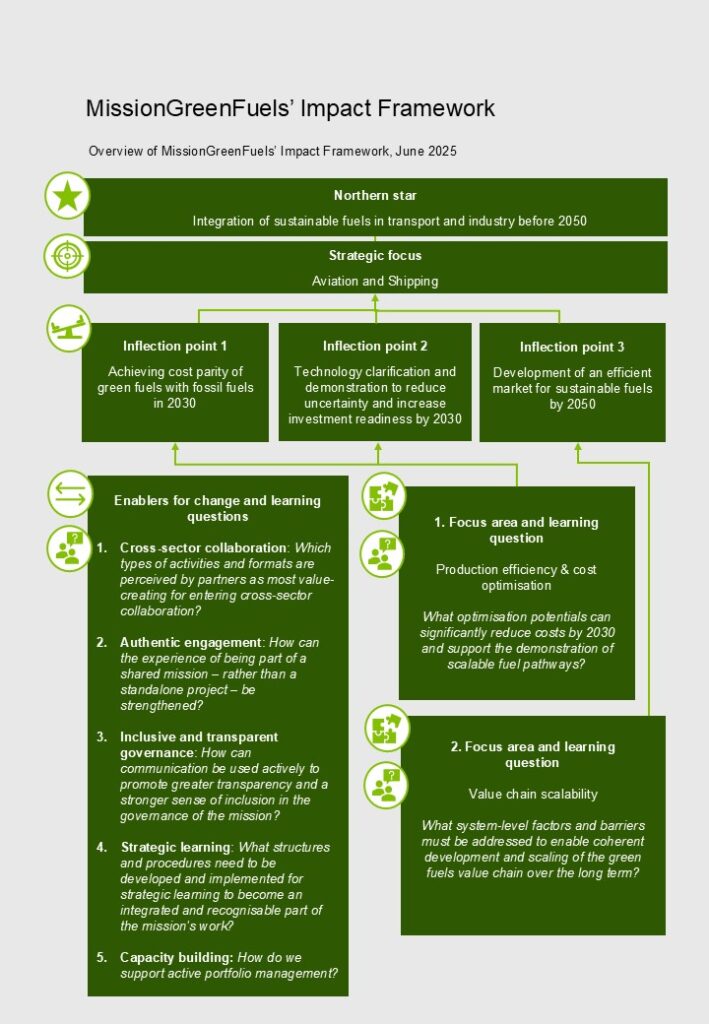MissionGreenFuels
Impact Framework
Introducing MissionGreenFuels' Impact Framework 2025
An impact framework is a strategic tool designed to describe, measure, and document the societal value created by research and innovation initiatives. It provides a structured approach to understanding how investments and activities lead to meaningful change both in the short term and over time.
Innovation Fund Denmark has developed a comprehensive impact framework to document outcomes, foster learning, guide strategic decisions, and ensure transparency. You can explore the full background and theory behind it here.
As one of Innovation Fund Denmark’s four Innomissions, MissionGreenFuels has built its own mission-specific impact framework. The MissionGreenFuels Impact Framework helps MissionGreenFuels stay focused, aligned, and adaptable. The framework links climate ambitions to concrete actions and learning processes, ensuring that each project contributes meaningfully to the mission’s goal and that progress toward a greener future can be tracked and demonstrated.
The MissionGreenFuels Impact Framework is built around five key elements that work together as a strategic compass:
1. Northern star
The Northern Star represents the mission’s overarching and long-term goal – a shared guiding ambition for all activities and decisions. It sets the direction and unites the partnership around a clear objective: integration of sustainable fuels in transport and industry before 2050.
2. Strategic focus
MissionGreenFuels strategically focuses on aviation and maritime transport – sectors with high energy demands and long investment cycles that make them especially dependent on sustainable fuels. By targeting these hard-to-abate sectors, the mission maximizes long-term impact where sustainable fuels can make the biggest difference.
3. Inflection points
Inflection points are pivotal moments in the mission’s development. They mark the transition from gradual progress to transformative change and are essential for achieving MissionGreenFuels’ long-term goals. In practice, inflection points occur when sustainable fuels move from being technologically feasible to economically attractive and widely adopted. These are the moments when new solutions reach critical mass and begin to reshape markets and practices.
Inflection points
1. Cost Parity with fossil fuels (2030)
Achieved when early adopters begin integrating sustainable fuels into procurement and investment decisions without relying on extraordinary subsidies. This creates economic incentives for green transition and paves the way for broader adoption.
2. Technological maturity and demonstration (2030)
Achieved when key technologies and value chains are sufficiently demonstrated and clarified to reduce uncertainty and increase investment readiness. This is not about commercialization but about creating clarity and confidence.
3. A Mature and efficient market (2050)
Achieved when a mature market system exists in which sustainable fuels are produced, traded, and integrated into business operations as a viable and standard option. This requires infrastructure, standards, demand, and stable regulatory conditions.
4. Two central focus areas
To maintain direction and drive real progress, MissionGreenFuels has identified two key focus areas. These help generate new knowledge and ensure that mission activities move toward the three tipping points. The focus areas serve as guiding principles for selecting new projects and planning portfolio development. They are closely linked to the mission’s learning objectives and ensure that both short-term and long-term needs are addressed. The focus areas are not static, as the path forward is uncertain. New insights may reveal new questions or shift the relevance of existing ones. Strategic learning may lead us to redirect efforts toward areas with greater potential for impact.
Focus areas
1. Which optimisation potential can significantly reduce costs by 2030 and support the demonstration of scalable fuel pathways?
This involves systems thinking across the production chain with a focus on process improvements and efficient use of energy and materials.
2. Which system-level factors and barriers must be addressed to enable coherent development and scaling of the green fuel value chain in the long term?
This requires a cross-cutting and analytical approach with the aim of building institutional readiness and strategic coherence.
5. Five enabling conditions
Enabling conditions are the foundational requirements for the mission’s success. They act as the “mortar” that binds projects together and creates coherence across the portfolio. It’s not just about supporting the right projects but also about building the collaborations, competencies, and structures needed to drive real change.
1. Cross-sector Collaboration
2. Authentic Engagement
3. Inclusive and Transparent Governance
4. Strategic Learning
5. Capacity Building
Are you using the Impact Framework for a fond application?
When preparing a project application, you should clearly demonstrate how your project contributes to one or more of the mission’s inflection points and relates to the two focus areas. The learning questions are central to understanding what the mission seeks. Use them as guiding principles to show what knowledge and solutions your project can contribute.

